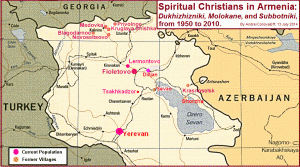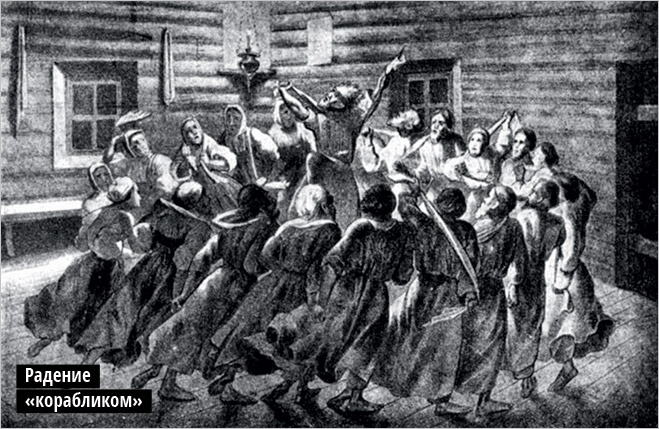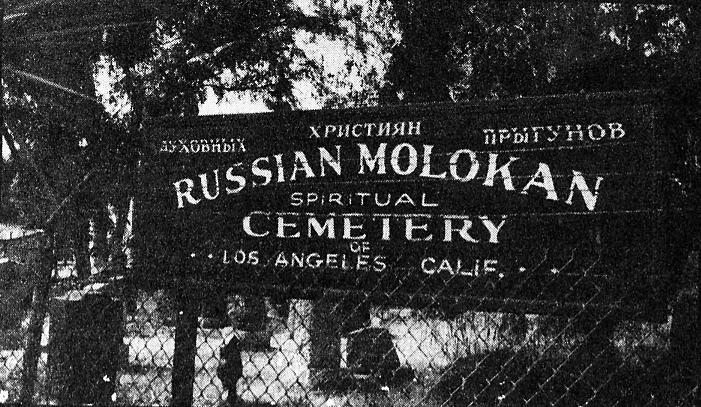Were Molokans the first to Speak in Tongues at Azusa?
Adopted from Andrei Conovaloff
American Molokan Dukh-i-zhiznik (lit. living in the Spirit) oral history (documented in the Book of the Sun: Spirit and Life, Dukh i zhizn’) reports that Molokani and Pryguny received the “outpouring of the Holy Spirit” in the Milky Waters region (now in Ukraine) in 1833. The diary of Vassili V. Verestchagin documents that Pryguny (lit. leapers) in the Caucasus in the early 1860s spoke in tongues, jumped to exhaustion, and held hands up in the air for more than an hour. These charismatic practices continue among Dukh-i-zhizniki in the U.S. and Australia.
From 1906 to 1909, the Apostolic Faith Mission conducted three services a day, seven days a week, for over three years or 1000+ services! Thousands of seekers received the “tongues” baptism, including many Molokani and Pryguny. Also many public Pentecostal revivals were conducted in tent meetings on Oake’s lot and other locations around the Flats area slums were Russian settled. English speaking Pryguny and other Russians immigrants often translated at the services. Oake’s lot later became Pecan Playground, at First and Pecan Streets.
In Molokans in America (pages 101-102, ch. 5), John K. Berokoff reports about the connection between Prygun leader Philip Mikhailovich Shubin and the early Pentecosts:
“During his 27 years in America he was the outstanding speaker and orator of the brotherhood with a wide acquaintance among non-Molokans , not infrequently taking a choir of singers to Pentecostal church meetings where he preached and explained the Molokan reasons for their migration. It was his wisdom, his profound knowledge of the scriptures plus his wide knowledge of Russian literature that enabled him to repel the periodic attempts by leaders of neighboring denominations—Baptists, Pentecostals, etc.—to proselytize the Molokan people …”
More evidence of connections between the Azusa Street Revival and the Pryguny is reported in the newspaper The Apostolic Faith, which was distribute free to 50,000 subscribers, when the population of Los Angeles was 250,000. Many Russian sectarians in Flats knew about this church and saw this free paper, especially since it reported about them in the first issue, the church was within walking distance, and elders exchanged visits.
1906 September — The Apostolic Faith (Volume 1 Number 1) — The first edition of the newspaper reports that Apostolic Faith Mission members spoke at a Prygun prayer meeting. In 1906, Pryguny held Sunday services at the Bethlehem Institutional Church and the Stimson-Lafayette Industrial School, and welcomed guests at both locations which were 1/2 block from each other and about 1/4 mile east of the Apostolic Faith Mission. The Pentecosts invited the Pryguny to attend their meetings, which many did with a translator:
RUSSIANS HEAR IN THEIR OWN TONGUE
“Different nationalities are now hearing the Gospel in their own “tongue wherein they were born.” Sister Anna Hall spoke to the Russians in their church in Los Angeles, in their own language as the Spirit gave utterance. They were so glad to hear the truth that they wept and even kissed her hands [showing respect]. They are a very simple, pure, and hungry people for the full Gospel. The other night, as a company of Russians were present in the meeting, Bro. Lee, a converted Catholic, was permitted to speak [translate] their [Russian] language. As he spoke and sang, one of the Russians came up and embraced him. It was a holy sight, and the Spirit fell upon the Russians, as well as on others, and they glorified God.”
1907 April — The Apostolic Faith (Volume 1 Number 7) — The 7th edition reports about the Russian and Armenian Pryguny in the Flats:
“Russians and Armenians in Los Angeles are seeking the baptism. The Armenians have a Pentecostal cottage meeting on Victor street, between 4th and 5th [Now under the I-5 Freeway]. Some have been baptized with the Holy Ghost.”
In his 2006 book, The Azusa Street Mission and Revival: The Birth of the Global Pentecostal Movement, Cecil Robeck reports that in 1906 Los Angeles had a population of 238,000 and was growing at the rate of 3,000 (1.3%) per month, as ~ 4,000 Russian sectarians migrated to the U.S. He mentions the Russian and Armenian Pryguny at least 5 times in his book:
[Page 57] Finally, between 1903 and 1912 several thousand Russians and Armenians arrived in the city, refugees from Russia’s increasingly repressive government. Unlike most Russians, they did not belong to the Orthodox church. They were [Spiritual Christian ethnic] Molokans, literally “milk drinkers,” a name they received because they refused to fast from dairy products during traditional fast days. More importantly, they could be described as a “proto-Protestant'” group, since they had been influenced by some of the sixteenth-century Reformers. They also had a special appreciation for the Holy Spirit. Many of them claimed that they had been directed to leave southern Russia through the gift of prophecy. They engaged in what was often described as ecstatic behavior, jumping and dancing; falling on the floor when they believed that they were possessed of the Holy Spirit to do so; and singing chant-like songs that strongly paralleled the “singing in the Spirit” (a multi-layered, harmony-rich singing in tongues that are unknown to the singers and are believed to be inspired by the Holy Spirit) at the Azusa Street Mission.
[Page 94] As the revival grew … Seymour celebrated the spread of the revival to other congregations … the Russian Molikan [sic] community, … He viewed them as fellow-workers.
[Page 138] While the mission was led by an African American pastor, dominated by and African American membership, and heavily influenced by African American worship patterns, it quickly developed into a multi-ethnic and multiracial congregation. … non-African-Americans did bring their own gifts and experiences. … Recent Russian and Armenian Molokan [Spiritual Christian] immigrants already practiced the unusual jumping and chanting also found at the mission. … This was a revival unlike any other the city of Los Angeles had ever seen … African Americans, Latinos, Armenians, Russians, Swedes, Germans, Italians, Chinese, Japanese, Native Americans, and other ethnic groups … bountiful expressions of ecstatic manifestation such as speaking in tongues, prophesying, claims of dreams and visions, trances, healings, exorcism, and falling “in the Spirit.”
[Page 153] “Singing in the Spirit” accomplished more than an expression of worship, however. It also provided a bridge that brought Russian and Armenian Molokans [Spiritual Christian Jumpers] into the mission — among them the Shakarian and Mushegian families. These families arrived in Los Angeles in the 1905 emigration. The Molokans commonly practiced a king of “sing-song” prayer, a form of vocal prayer and praise that resembled singing in Spirit.” Walking down San Pedro Street in 1905, Demos Shakarian, grandfather of the Demos Shakarian who would later found the Full Gospel Businessman’s Association, and his brother-in-law, Magardich Muchegian, passed the Azusa Street Mission. As they drew near, they heard sounds of praying, singing, and speaking in tongues coming from the mission — expressions that they identified as similar to their own. The single phenomenon of “singing in tongues” convinced Demos to embrace the mission as a place his family could worship. From the moment he heard it, he concluded that God was also beginning to move to America just as He had in their homeland of America and in Russia.”(27)
[Pages 189-190] At the same time a group of Armenians and Russians [Spiritual Christian Pryguny], who had come to Los Angeles in the Molokans immigration, opened cottage prayer meetings on Victoria Street between West Fourth and Fifth Streets that would quickly develop into an Armenians-language Pentecostal church.
American-born Armenian-Prygun historian Joyce Bivin comments: We have a similar story in our community about the Azusa Street Revival. The story goes like this — quoted from a letter by M. Mushagian:
“Our people came to Los Angeles right after the Azusa Street Revival. They used to attend the meetings even though they didn’t understand the American language. They saw that the Holy Spirit was moving there like it did in the Old Country. So they accepted Pentecostal because they believed in Acts 2:4.”
 The Armenians apparently were worshiping in this manner, including dancing in the Spirit, (jumping, which my grandmother did at one of the Paskha meetings and the next day mother told me she was healed of whatever affliction she had at the time), prophesying, speaking in tongues, etc. before they came to America. I wasn’t aware the Molokans responded to the Azusa Street meetings. After the Armenians visited the Azusa Street meetings, they eventually changed their identity from Armenian Molokans to Armenian Pentecostals. Though they kept the Molokan traditions in their worship, their theology shifted from focusing on Jesus and M.G. Rudometkin (whose book was next to the Bible on the table) to Jesus’s teachings as defined by Pentecostal/Protestant doctrine.
The Armenians apparently were worshiping in this manner, including dancing in the Spirit, (jumping, which my grandmother did at one of the Paskha meetings and the next day mother told me she was healed of whatever affliction she had at the time), prophesying, speaking in tongues, etc. before they came to America. I wasn’t aware the Molokans responded to the Azusa Street meetings. After the Armenians visited the Azusa Street meetings, they eventually changed their identity from Armenian Molokans to Armenian Pentecostals. Though they kept the Molokan traditions in their worship, their theology shifted from focusing on Jesus and M.G. Rudometkin (whose book was next to the Bible on the table) to Jesus’s teachings as defined by Pentecostal/Protestant doctrine.
The first place our people gathered to worship was on Boston Street. The next place was on 431 S. Pecan Terrace, in a large room where my great grandfather eventually turned into a bath house. Then they moved to Gless Street [all in the Flats] and next to Goodrich Blvd before moving to Hacienda Heights. The church today is located in Hacienda Heights, off Hacienda Blvd. on West. It’s the first entrance on the right after you turn on West.
First person to speak in tongues in the Assemblies of God was William Jethro Walthall of the Holiness Baptist Churches of Southwestern Arkansas
 By Glenn Gohr
By Glenn Gohr
A/G Heritage, Fall 1992
Although the modern Pentecostal movement relates its beginnings to Charles Parham, who formulated classical Pentecostal theology at his Bible school in Topeka at the turn of the century, throughout history, from apostolic times to the present, there have been certain religious groups and isolated cases of individuals who have experienced tongues-speaking and spiritual gifts.
William Jethro Walthall, who founded the Holiness Baptist Churches of Southwestern Arkansas, a group which later merged with the Assemblies of God, is an important figure who received his baptism in the Spirit prior to Parham’s launching of Pentecostalism in 1901.
Walthall’s Spirit baptism, which occurred 113 years ago, is one of the earliest documented cases of speaking in tongues in North America. Earlier instances of tongues-speaking have been reported among the Shakers, the Holiness Movement, the “Gift People” or “Gift Adventists” in New England, and others. It is very possible that Walthall is the earliest person to have received the baptism in the Holy Spirit and who later joined the Assemblies of God.
William Jethro Walthall was born in Nevada County, Arkansas, March 9, 1858, the son of Charles Featherston Walthall and Mary Jemima Meador. His father died in 1863 at Rock Island, Illinois, as a prisoner in the Civil War, and his mother died 2 years later. Orphaned at age 7, he was reared by his widowed grandmother. However he had no Christian upbringing, so it was not until 1877 that he was confronted with the claims of the Gospel. That happened when he attended an old-time Methodist meeting and conviction gripped his heart, resulting in his conversion at age 19. Two years later, on August 3, 1879, he was married to his first wife, Melissa P. “Missy” Beavers, who bore him two children, Millard and Ibber Mae. After Melissa passed away, he married Hattie Vaughn on March 24, 1915.
While a young Christian, Walthall had a yearning for more of the workings of God in his life. He earnestly began to seek for a fullness of power to witness and better serve the Lord. This spiritual hunger led him to carefully study the Book of Acts and other scriptures. There he found recorded an enduement with power of the Holy Ghost which had accompanied the Early Church. He wanted this same experience in his life.
During a season of fervent prayer, he received a mighty infilling of the Spirit on September 3, 1879. Since he had never heard of the baptism of the Holy Spirit, he did not receive his Baptism through any prescribed theory or method.
Until that time all he knew about the Holy Spirit came from the teachings of the Methodists and Baptists. But this was something new. His experience came about in answer to prayer and through his own study of the Word of God. From the outset he understood that his experience corresponded with the records given in the Book of Acts.
In his testimony, Walthall describes his infilling by saying, “I was carried out of myself for the time being.” From the time of his Baptism, he testified that he often felt the strong anointing power of God. At times he would fall under the power of God when the Spirit came upon him. He also spoke in tongues as the Spirit directed.
For two years, during which time the Holy Ghost would often fall on me, I walked with God. Sometimes while in service and sometimes when alone in prayer I would fall prostrate under His mighty power. While under this power my tongue seemed to be tied in the center and loosed at both ends. I knew nothing of the Bible teaching on the Baptism or speaking with tongues, and thought nothing of what had happened in my experience.
Walthall was ordained by the Missionary Baptist Church on May 29, 1887, and served several congregations in Southwest Arkansas. He was active in various associational committees including foreign missions and temperance. In 1891 he was pastor of Piney Grove Church at Boughton, Arkansas, which was a part of the Red River Baptist Association of the Southern Baptist Convention. In fact, the annual associational meeting was held that year at Walthall’s church. The next year he was pastoring two churches at Bluff City and Prescott. From 1894-1895 he was pastoring at Stephens. The last Baptist church he pastored was at Buena Vista. Because of the prevalent view of the Holy Spirit held by Baptists, Methodists, and other mainline churches, Walthall had some reservations about his experience, as he shares in his testimony:
The ordinary Methodist and Baptist teaching was all that I knew, and, of course, that served to diminish my experience and to paralyze my faith rather than build me up. In the meantime, I began preaching a work to which I was called when the blessed Spirit filled me. I always felt that there was a lost chord in the Gospel ministry. My own ministry never measured up to my ideal, nor did the teaching of my church (Baptist) measure up to my experience.
Then in 1895 Walthall came into contact with the Holiness revival. Its emphasis on the work of the Holy Spirit impressed him. Its teachings approximated his ideal more nearly than anything else, but he never fully ascribed to the Holiness theology. He could not accept its theory of sanctification; nor could he accept its abridgement of the supernatural. Even so, the Holiness revival opened him up to a larger sphere of ministry, This in turn gave him the encouragement he needed to preach the full gospel message as he understood it from the Scriptures. As he began to preach a full gospel message, the Baptist leaders excluded him from his church and he was ostracized from the Baptist ministry in 1896. He continued preaching on his own.
After my new vision of the Word of truth, and my expulsion from the Baptist fellowship and ministry, I went alone with a new zeal in an independent, plodding ministry, with church and school houses closed against me. I was looked upon with suspicion, as unbalanced but was so animated by the divine presence that it seemed at times as if terrestrial bearing was almost lost. Baptist minister, J. C, Kelly, and other Baptists who became disfellowshipped because of their beliefs in entire sanctification and the work of the Holy Spirit.
He was soon followed by another Baptist minister, J. C. Kelly, and other Baptists who became disfellowshipped because of their beliefs in entire sanctification and the work of the Holy Spirit.
Molokans among the first to speak in tongues in America
Were Molokans the first to Speak in Tongues at Azusa?
By Andrei Conovaloff American Molokan Dukh-i-zhiznik (lit. living in the Spirit) oral history (documented in the Book of the Sun: Spirit and Life, Dukh i zhizn’) reports that Molokani and Pryguny received the “outpouring of the Holy Spirit” in the Milky Waters region (now in Ukraine) in 1833. The diary of Vassili V. Verestchagin documents that Pryguny (lit. leapers) in…
The Forgotten Azusa Street Mission: The Place where the First Pentecostals Met

By Cecil M. Robeck, Jr. For years, the building on Azusa Street has also been an enigma. Most people are familiar with the same three or four photographs that have been published and republished through the years. They show a rectangular, boxy, wood frame structure that was 40 feet by…
First Pentecostal Missionaries to Bulgaria
By Dony K. Donev, D.Min. Historical and Doctrinal Formation of Holiness Teachings and Praxis among Bulgarian Pentecostals (Research presentation prepared for the Society of Pentecostal Studies, Seattle, 2013 – Lakeland, 2015, thesis in partial fulfillment of the degree of D. Phil., Trinity College) Interestingly enough, the arrival of the first Pentecostal missionaries to…









